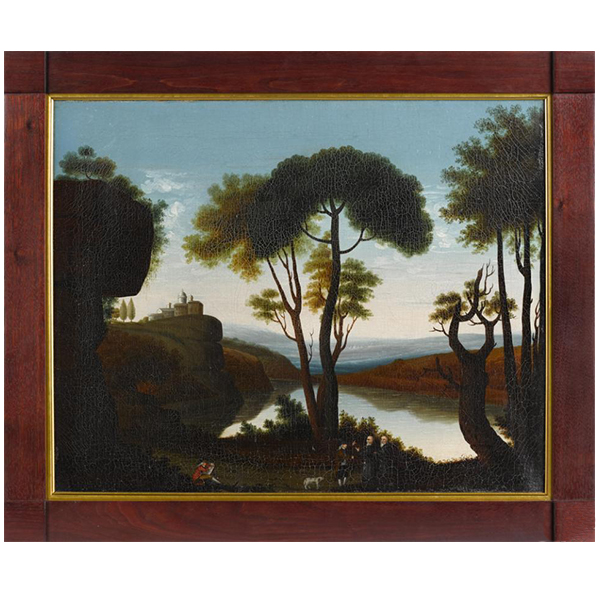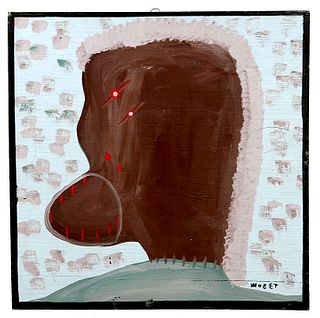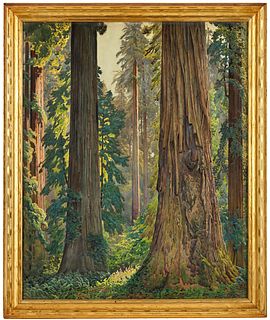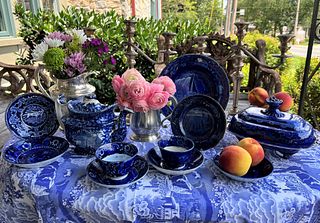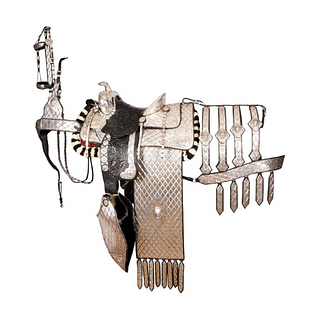Americana Folk Art – Celebrating Timeless Traditions With Creativity
“A thing of beauty is a joy forever…” The first line of John Keats’ poem, Endymion, is an apt analogy to describe folk art pieces dating back to the 18th century. Every folk art object is a labor of love, handcrafted with a sense of simplicity, honesty, and resourcefulness. However, the timelessness of these items lies not only in their visual appeal but also in the practical nature of their designs. Handmade by people without any formal training, folk art pieces are meant to serve a utilitarian purpose with aesthetics in mind. A blend of simplicity and resourceful creativity is what makes folk art an interesting genre. Everyday objects such as crockery, stoneware, quilts, and chests exemplify folk art at its best.
Lot 116, Black toleware coffee pot, ca. 1900; Sold at Pook & Pook, Inc for $3,936, October 9, 2020
During the 1920s, folk art in general and Americana art, in particular, gained significant recognition. This is the period described as the “Roaring Twenties.” It was the decade that witnessed a dramatic transition in the social and political environment of the United States. For the first time, the majority of Americans lived in urban areas rather than in small towns or on farms. These new city-dwellers wanted to fill their homes with art forms that would take them closer to their roots. It was this collective consciousness that prompted the nostalgia for a bygone era of Americana folk art. At the same time, the growing popularity of Modernism was constantly counteracted by those who advocated Colonial Revival.
Folk paintings – depicting everyday scenes in strong colors
It was during the Industrial Revolution of the 19th century that American folk painting came to the fore. With a majority of the population now living in cities, people decorated their homes with paintings that depicted the everyday lives of common people. Today, Americana folk art paintings are included in museums the world over.
The subject matter of folk paintings varies widely. Portraits, seascapes, rural landscapes, floral patterns, and textured surfaces are some of the popular themes. Beyond depictions of humans, fauna portraits in watercolor and gouache are also common. Paintings of well-known personalities and events are particularly valued as well.
Lot 428, Edward Hicks (American 1780-1849), oil on canvas landscape with three figures; Sold at Pook & Pook, Inc for $23,370, April 2016
Edward Hicks’ folk art paintings
One of the most prominent folk painters was Edward Hicks (1780 - 1849), an eminent Quaker from Pennsylvania. He took to painting to fund his preaching occupation. When he was 13 years old, Hicks started an apprenticeship with contemporary coach makers William and Henry Tomlinson. During this period, Hicks learned the art of coach painting. He later started to paint domestic objects and farming equipment to increase his income. However, Hicks’ Quaker community did not quite approve of his subject matter. As a result, Hicks gave up decorative painting for a time and limited himself to utilitarian items. As his financial difficulties deepened, however, his friends urged him to resume decorative painting. This eventually became his main source of income and Hicks became one of the most distinguished figures of Americana folk painting.
Practicing simplicity in expression through generations
Folk art is all about the simple and honest expression of everyday objects. Handcrafting skills are passed on from one generation to the next. These traditions are well preserved and cherished in local communities. To create quilts, chests, duck decoys, and tools, artisans use many different techniques. These include chiseling, carving, sewing, weaving, hammering, embroidering, and knitting.
Americana folk art – a celebration of civic ideals, traditions, and national pride
Americana folk art is all about celebrating age-old traditions, patriotism, and local accomplishments. Americana collectors may be interested in bunting, flags, embroidery, carved eagles, and various other representations of democracy and liberty. Many collectors are also interested in objects used by fire brigade volunteers.
Lot 54, The Gilley-Wilson Eider, Augustus "Gus" Aaron Wilson (1864-1950) Sold at Copley Fine Art Auctions for $186,000, July 19, 2018
Uniquely hand-crafted wood carvings
Wood carving is a significant part of folk art and is also a favorite among collectors. Carved wood objects often demonstrate how Americana folk artists combine functionality and aesthetics. The more elaborate an object, the more it tends to be valued in the folk art collector’s market. However, duck decoys are an interesting exception to this rule. Even the simplest designs and weathered surfaces are highly treasured by collectors. Many of these original wood carvings fell out of fashion after World War II. Although the plastic variety is commonly found in the market, the hand-crafted and traditional designs are prized possessions for many collectors.
Tramp art — aesthetically repurposed wood
A genre that emerged near the end of the 19th century, tramp art is closely related to Americana folk art. Tramp artists reused wood from storage containers, shipping materials, and cigar boxes. The derived wood was repurposed into hope chests, Oval Mirrors, sideboards, and other pieces using chip and notch carving techniques.
Every folk art quilt has a story to tell
Quilts are some of the most fascinating folk art forms. They occupy a pride of place in many folk art traditions. The applique technique sets quilts apart. Generally made from wool and cotton, folk art quilts also feature embroidery. Some quilts include family names alongside homes, farms, animals, and plants.
Lot 307, Rare Molded Sheet Copper and Zinc Steam Pumper and Horses Weathervane, Sold at Skinner for $28,750, November 2, 2019
Antique weathervanes, all-time collector favorites
Antique weathervanes are some of the best folk art objects for those interested in the late 19th and early 20th centuries. Many wooden horse weathervanes from this period display the sheer creative skills of artisans. With their rustic painting styles and muted colors, these folk art pieces are perfect for history buffs.
The whirligig is an interesting variation on traditional weathervanes. With their frantic movement that follows the wind, whirligigs bring a humorous twist to antique weathervanes.
Lot 432, Pennsylvania painted black unicorn dower chest, Sold at Pook & Pook, Inc for $9,840, January 18, 2020
Vibrant furniture
Handmade with strong timbers, folk furniture pieces are carved and painted in bold hues. These items often bear family names or display vibrant motifs. No matter the decoration, many folk furniture items were designed with functionality in mind.
From keeping timeless traditions alive to celebrating civic ideals, Americana folk art is a diverse mix of aesthetics and practicality. It can bring both value and interest to a collector’s treasure trove. Find upcoming Americana folk art auctions on Bidsquare.
- Quilts as a 2025 Design Trend: A Celebration of American Heritage and Craftsmanship
- A Celebration of Sports History and Collectibles
- Antiques and the Arts Weekly Q&A: Allis Ghim
- The Thrill of Sports Memorabilia Auctions: A Collector’s Paradise
- Demystifying Coin Condition: A Guide to the Sheldon Grading Scale
- Snoopy & Friends: A “Peanuts” Auction at Revere
- Colorful Chinese Monochromes at Millea Bros
- 12 Holiday Gifts for the “Impossible to Buy For” on Bidsquare
- Alluring Art Objects and Accessories from the Estate of Chara Schreyer
- Kimball Sterling's One-Owner Outsider and Folk Art Collection Showcases Masters of the Unconventional



 EUR
EUR CAD
CAD AUD
AUD GBP
GBP MXN
MXN HKD
HKD CNY
CNY MYR
MYR SEK
SEK SGD
SGD CHF
CHF THB
THB.jpg)
